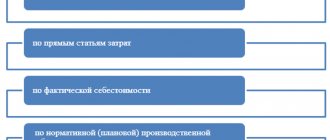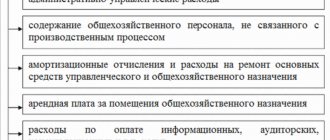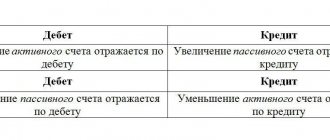Account 29 of accounting is an active account “Service production and facilities”, serves to summarize information on the costs of service production for the production of products, performance of work or provision of services, including costs on the balance sheet of the following types of activities:
- Department of Housing and Utilities;
- a consumer service workshop, for example, a sewing shop;
- dining room, buffet;
- preschool for children;
- sanatorium, holiday home, etc.
Concept and purpose
The production structure of any industrial enterprise is based on the interconnection of its divisions. This includes affiliates and subsidiaries, representative offices and branches, as well as individual product manufacturing lines. Among them are large industrial units (factories), as well as its constituent parts - departments (shops), sections, teams. The production structure may include a service facility. Its divisions do not participate in the creation of products for sale, but provide for the needs of main and auxiliary production.
The main task of the service economy is to ensure the continuous and optimal functioning of auxiliary and main production, by meeting various industrial needs. If necessary, its workshops can take on part of the orders. This sometimes happens when equipment breaks down or when there is a need to make increased deliveries of products.
Composition of service production
This industrial division plays an important role in the production processes of products in the main activity of the enterprise. Service production is able to provide semi-finished products, materials and various services to all other departments. Typically this unit consists of:
- Transport workshop - provides services for the transportation of goods, equipment, materials and other material assets necessary for production. It is important that transportation is carried out only within the enterprise. According to its structure, it can be divided into sections (operational, dispatch, repair, etc.).
- Sales and supply services - provides the necessary materials and equipment, carries out work on the disposal of materials and other valuables that are not suitable for use. Carries out the sale of unclaimed inventories.
- Warehousing - stores and collects materials and equipment that may later be useful to the main or auxiliary production.
- Household premises and catering departments.
In addition, many large industrial enterprises have their own social and cultural complex, consisting of children's institutions (camps, kindergartens), cultural centers or recreation centers, and dormitories for employees. The costs of maintaining such premises, including utilities, are also reflected as part of the costs of service production.
Account 29
A large amount of information about the activities of the service business requires the allocation of a separate account for collecting data and recording it in accounting. Section III of the Standard Chart of Accounts contains account 29, which serves for such purposes. It has an active structure, since it is reflected in the assets of the balance sheet. In the process of carrying out business transactions, entries occur, which in debit mean an increase in direct expenses for the activities of service production, and in credit - their write-off and distribution among items.
This account, like other Section III accounts, accumulates expenses over a period. At the end of the month, amounts are written off to the debit of other accounts. Thus, there is no balance at the end of the period. Account 29 has a distinctive feature - it takes into account only direct expenses that are associated with the direct functioning of service farms and departments.
Scope of application
Every enterprise employs people who receive wages and other benefits for their work. In order to keep records of funds issued, on the basis of Order of the Ministry of Finance No. 94n dated October 31, 2000, all settlements with personnel for wages are attributed to account 70 in the accounting department. It also groups data on the payment of bonuses, compensation, benefits, dividends on shares, and income from securities.
Card
The credit balance on account 70 means the company's debt to employees. Therefore, at the end of the reporting period it is necessary to calculate it and include the amount in the liability item of the balance sheet.
Note! It is possible to record not only by each employee, but also by type of transaction: payroll, benefits, compensation, deductions, etc.
Analytical accounting
Service production may consist of many divisions. The activities of each of them must be documented. For these purposes, subaccounts 29 are opened, which are intended to collect information in a specific area and for similar purposes. An enterprise can keep records regarding service facilities on the following analytical accounts:
- 29/1 “Housing and communal services” - to account for the costs of maintaining housing facilities (dormitories, utilities) on the balance sheet of the enterprise;
- 29/2 “Agricultural subsidiary farms” – collection of costs aimed at fattening poultry or livestock, growing crops;
- 29/3 “Household services” - to account for the costs of maintaining household organizations and its personnel (baths, hairdressers, laundries, etc.);
- 29/4 “Children’s preschool institutions” – collection of information on the costs of preschool institutions;
- 29/5 “Maintenance of sanatoriums and other health institutions”;
- 29/6 “Cultural institutions” - to account for the costs of maintaining cultural palaces owned by the enterprise and the costs of holding entertainment events;
- 29/7 “Catering divisions” – maintenance of canteens and buffets on the balance sheet of the enterprise.
Analytical accounting of production costs, implementation of work (provision of services) by service units should be organized separately for each type of activity.
Debit account 29
The reader already knows that account 29 is active. This means that any receipt of funds will be reflected in debit. In this case, revenue is considered to be the creation of new expenses for service production. Here we indicate the direct costs that arose in connection with the performance of work or the manufacture of products for our own needs. The amounts of materials used and other valuables are written off from the credit of their accounting accounts to debit 29. Expenses of auxiliary production, if they arise, are also written off by posting Dt 29 Kt 23.
It is worth knowing that general business expenses arising from the manufacture of products or the provision of services (performance of work) are not taken into account as part of the direct costs of service production if they were intended for their own needs (with the exception of construction and major repairs). If the result of the activity was transferred to a third party, then part of the general business expenses is written off as direct costs of service production: Dt 29 Kt 26.
“Low value” fixed assets
FAS 5/2019 established the criteria for classifying assets as inventories. One of them is the use of assets in one operating cycle or within 12 months. This means that the new standard prohibits accounting for “low-value” fixed assets in inventories, although this is permitted in clause 5 of PBU 6/01 “Accounting for fixed assets”. A new standard is a later document of the same level and legal force; in case of a conflict of norms, it will take precedence.
In addition, the new FSBU 6/2020 “Fixed Assets” also requires that the cost of low-value assets that can be recognized as fixed assets be expensed. From the beginning of the application of this standard, the conflict is eliminated (no later than 2022).
In this regard, we recommend that the accounting policy establish the procedure for accounting for “low-value” fixed assets - and attribute their cost directly to expenses.
Create an accounting policy based on the parameters of your organization
Account credit 29
The costs of producing products or performing work in service production must be taken into account in the financial result of the enterprise. They are written off on the credit of account 29. In addition, this part also takes into account the amounts of the actual cost of products manufactured or services provided.
Account 29 “Service production and facilities” interacts with the accounts of inventory items or department costs. If the results of activities are aimed at selling to a third party, then the amounts are written off to the debit of account 90.
Difficulties of automatic closing in 1C
From the author! Automatic closure of account 29 raises many questions and confusion for the reason that this feature is not specified in the standard 1C 8.2 configuration.
It would seem that developers should take into account that there are other cost accounts besides those listed in the regulatory operation “Closing accounts 20, 23, 25, 26” of the “Period Closing” processing.
However, the typical configuration ignores account 29 and leaves it for the accountant to handle manually. To achieve its inclusion in the list of routine operations, programmers need to make an effort and add their own processing.
In contrast, the 1C 8.3 configuration assumes that a production organization has 29 accounts. Therefore, it can be closed using the regulatory operation “Closing accounts 20, 23, 25, 26”. It is carried out at the third stage of closing the period after all possible costs have been accrued by previous regulatory operations.
Since 29 must be closed at the end of the month, the balances may show:
- Work in progress remains.
- There were errors in the accounting.
Typical transactions on account 29
Having understood the principle of interaction of account 29 with other accounting accounts in the process of carrying out business transactions, you can begin to consider typical transactions.
Account assignments for account 29
| Dt | CT | Characteristics of a business transaction |
| 29 | 71 | Expenses of servicing production are written off to an accountable person |
| 29 | 28 | The cost of production includes losses from defects produced by the service facility |
| 45 | 29 | Products manufactured by service production were shipped to a third party |
| 90.2 | 29 | The cost of sales of products manufactured by service production was written off |
| 80 | 29 | The work in progress of the service business was transferred in full to the member of the partnership |
| 97 | 29 | Maintenance production costs are included in deferred expenses |
| 29 | 11 | The cost of young animals used for the needs of the service farm has been written off |
Payment of salaries to branch employees
On September 30, 2015, the branch of Metallurg LLC paid salaries to employees:
- workers of the metal rolling shop - 412,500 rubles;
- economists of the financial department - 194,300 rubles.
On October 3, 2015, the branch received funds from Metallurg LLC to make payments.
The accountant of the head office of Metallurg LLC made the following entries in the accounting:
| Dt | CT | Description | Sum | Document |
| 20 | 79.2 | Salaries accrued to employees of the branch's metal rolling shop | 412,500 rub. | Payroll |
| 26 | 79.2 | Salaries accrued to employees of the financial department of the branch | 194,300 rub. | Payroll |
| 79.2 | 51 | Funds for paying salaries were transferred to the branch (RUB 412,500 + RUB 194,300) | 606,800 rub. | Payment order |
In the accounting of the branch of Metallurg LLC, salary payments are reflected by the following entries:
| Dt | CT | Description | Sum | Document |
| 20 | 70 | Salaries accrued to employees of the branch's metal rolling shop | 412,500 rub. | Payroll |
| 26 | 70 | Salaries accrued to employees of the financial department of the branch | 194,300 rub. | Payroll |
| 79.2 | 20 | Expenses for paying wages to employees of the metal rolling shop are included in settlements with the head office | 412,500 rub. | Payroll |
| 79.2 | 26 | Expenses for paying salaries to employees of the financial department are included in settlements with the head office | 194,300 rub. | Payroll |
| 51 | 79.2 | Funds have been credited from the head office to pay salaries | 606,800 rub. | Bank statement |
| 50 | 51 | Funds were withdrawn from the current account to pay salaries | 606,800 rub. | Bank statement, cash receipt order |
| 70 | 50 | Salaries were paid to employees of the metal rolling shop and financial department through the cash register | 606,800 rub. | Account cash warrant |
An example of making entries for account 29
Let's consider a situation in which an enterprise runs a children's health camp. Gradually, cost items will be formed that will need to be reflected in accounting data. For example: as a result of the first shift of children’s holidays, the following expenses arose:
- depreciation of fixed assets in the amount of 3200 rubles;
- use of utilities – 21,000 rub. (VAT RUB 3,784);
- staff salary – 100,000 rubles;
- mandatory contributions – 22,000 rub.
Account 29 will be replenished with the following entries:
- Dt 29 Kt 02 for 3200 rub. – reflects the amount of depreciation of the camp property;
- Dt 29 Kt 60 for 17,216 rub. – utility costs are taken into account (excluding VAT);
- Dt 19 Kt 60 for 3784 rub. – accepted for accounting for VAT on utility bills;
- Dt 29 Kt 70 per 100,000 rub. – wages for camp staff were accrued;
- Dt 29 Kt 69 for 22,000 rub. – the amount of contributions to extra-budgetary funds was posted.
Accounting for production costs (in this case, for the provision of educational and health services) was reflected in the debit of account 29. The final result will be written off to account 91.
What are the subaccounts?
Each employee of the company creates his own sub-account, which will account for all accruals, payments and deductions for the entire period of his work in the organization. For ease of work, they are combined by department and divided into the following groups:
- payments to employees included in the company's staff;
- payments to employees with whom a contract has been concluded;
- payments to employees working part-time;
- payments to employees with a confirmed disability group.
Each organization itself has the right to create and approve the analytics it needs, but taking into account the requirements of Order of the Ministry of Finance No. 94n dated October 31, 2000.
The following subaccounts are most common at enterprises of different levels:
- 70.1 - used for payroll;
- 70.2 - serves to reflect deposited amounts;
- 70.3 - salary debts are reflected;
- 70.4 - shows the amounts to be issued;
- 70.5 - amounts transferred to deposits are entered;
- 70.6 - reflects the rounding amounts used when calculating wages.
Maintenance of our own production facilities
What will the postings look like if the service production carries out work in order to provide the main or auxiliary production with the necessary materials or other means? Reflecting transactions of this type is quite simple. To begin with, you should debit account 29 the costs associated with the process of manufacturing products in the service production (cost of materials, wages, electricity consumed, etc.). After completion of the process, all accumulated costs in connection with the completion of this task are written off as a debit to the main or auxiliary production account.
29 accounting account serves to reflect information about the activities of service production or farming, which sometimes forms a large complex of divisions of various directions. After accumulation in the debit of the account, expenses are subject to write-off depending on the nature of their occurrence. The account is closed, and everything starts all over again in the new month.
Characteristics
To obtain reliable information about payments, analytical records are maintained for each employee of the enterprise. To see the total amount of accruals, you can create a balance sheet. It will show all payments made, deductions, as well as the company’s possible debt to employees. In addition, it is used for:
- formation of payment and settlement statements;
- creating a journal order;
- employee income cards;
Analysis of account 70 is used when preparing reports on personal income tax and insurance premiums.
To answer question 70, is the account active or passive, you need to look at how income and expenses are distributed over it. Debit 70 of the account shows the expenses incurred: salaries paid, bonuses, benefits, as well as alimony, personal income tax, and fines withheld from employees. The loan is used to accrue amounts due to employees.
According to the characteristics of account 70, debit shows the debt of employees, credit shows accrued but not paid amounts. Usually it has a credit balance, because salaries are accrued until the end of the current month and paid only in the next month. Thus, in accounting it is passive.
Important! For the convenience of accounting, an account card 70 is created. This register allows the accountant to avoid possible errors in accounting and timely track all transactions performed in the context of calculating wages to employees.








